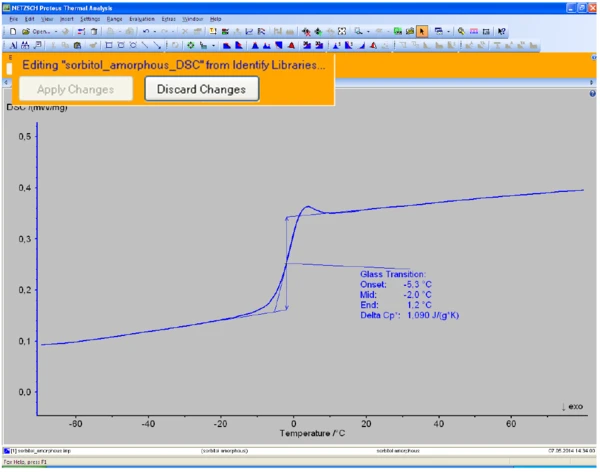Introduction
Besides being useful for material identification and quality control [1, 2], the Identify curve recognition and database system can also be used as an archiving system. This is true for the NETZSCH database entries as well as for a user’s own measurements and literature data added to the database. Currently, two NETZSCH libraries with entries from the polymer field and another one with organics, food and pharma entries are included in the scope of delivery. Any database entry (see below) is easily accessed so that evaluated measurement curves from NETZSCH libraries can, for instance, be called up quickly in order to show application examples.
Software Capabilities
Reference [3] shows how easily Identify libraries, classes, measurements and literature data can be managed. Everything is available at a glance and creating, renaming, deleting or viewing the content of a database entry is simple. A new measurement curve can also easily be added to a library.
Figure 1 displays the implementation of Identify within the NETZSCH Proteus® software [1-3]. With one click of the left mouse button on a particular measurement of the hit list, its DSC curve is immediately displayed in the same plot as the current measurement. Of course, possible hits are limited to data that belong to the libraries selected for the actual search. A click with the right mouse button offers the possibility to either view details of literature data or to immediately restore the analysis state of a measurement.

As can be seen from figure 2, one could work with such an analysis state and perform operations such as printing and exporting. Any modification of the evaluation results made by the user can either be applied or discarded for the database when going back to the main view of Identify. However, since NETZSCH library entries are write-protected, they cannot be modified, unlike user’s library entries.

Another very powerful way to restore an analysis state of a database entry is accessible via “Manage Libraries/Classes...“ (see figure 3). This allows not only to select a particular library, but also to use an alphabetical search filter to find a particular database entry. In this example, “sor” was typed in by the user in order to find the database entry “sorbitol_amorphous” which can then again be restored with a click on the right mouse button.

Under ‘Settings’, users can define the location of the user portion of the Identify database; for example, somewhere in the computer network. Users can also select among multiple user-created databases, including simultaneously accessing databases from different computers. In this way, databases can be shared among multiple users at the same time.
Summary
- Identify is not only useful for material recognition and quality control [1, 2], it also serves as an archiving system for NETZSCH and user data.
- There is easy access to any database entry – especially evaluated curves can quickly be displayed, their analysis states restored and any modifications of evaluations can be applied or discarded for the database with one click.
- Libraries and their entries are easily managed (created, deleted or renamed) and adding a new measurement curve to a library is simple, too [3].
- Multiple user databases can be selected and can be shared with several users at the same time.
- NETZSCH library measurements serve as an archive of application examples for demonstration purposes.